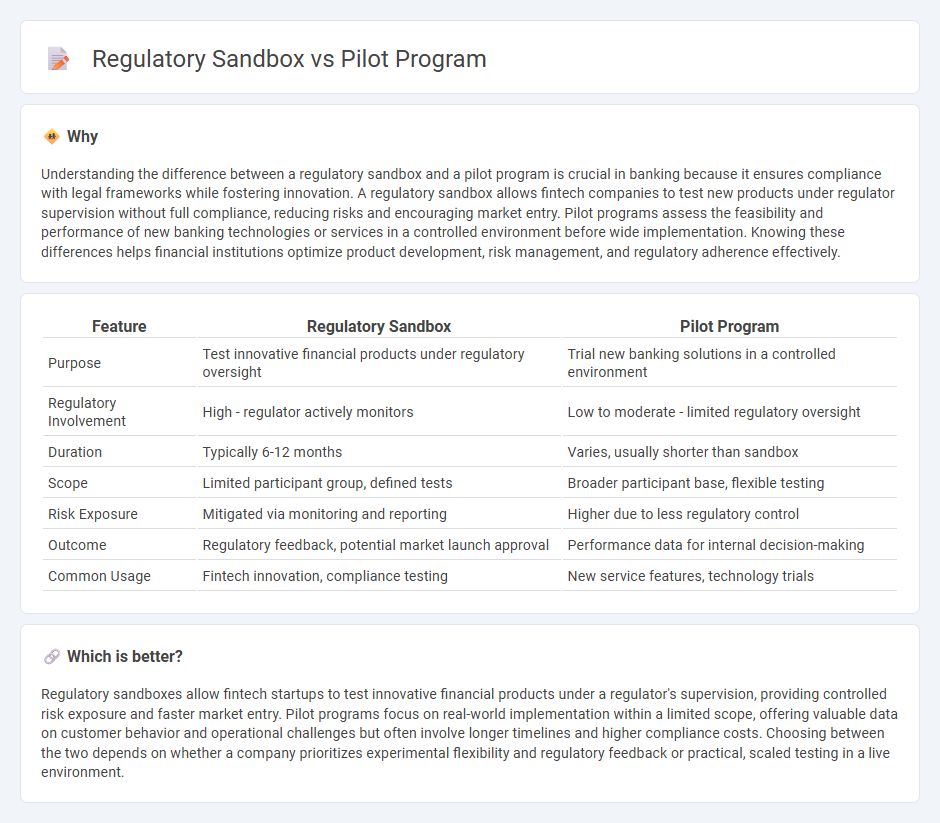
Regulatory sandboxes allow banks and fintech firms to test innovative financial products and services under relaxed regulatory conditions, promoting innovation while safeguarding consumer interests. Pilot programs enable controlled real-world implementation of new banking solutions to assess feasibility, scalability, and risk management before full-scale deployment. Explore how these frameworks accelerate innovation and enhance compliance in modern banking.
Why it is important
Understanding the difference between a regulatory sandbox and a pilot program is crucial in banking because it ensures compliance with legal frameworks while fostering innovation. A regulatory sandbox allows fintech companies to test new products under regulator supervision without full compliance, reducing risks and encouraging market entry. Pilot programs assess the feasibility and performance of new banking technologies or services in a controlled environment before wide implementation. Knowing these differences helps financial institutions optimize product development, risk management, and regulatory adherence effectively.
Comparison Table
| Feature | Regulatory Sandbox | Pilot Program |
|---|---|---|
| Purpose | Test innovative financial products under regulatory oversight | Trial new banking solutions in a controlled environment |
| Regulatory Involvement | High - regulator actively monitors | Low to moderate - limited regulatory oversight |
| Duration | Typically 6-12 months | Varies, usually shorter than sandbox |
| Scope | Limited participant group, defined tests | Broader participant base, flexible testing |
| Risk Exposure | Mitigated via monitoring and reporting | Higher due to less regulatory control |
| Outcome | Regulatory feedback, potential market launch approval | Performance data for internal decision-making |
| Common Usage | Fintech innovation, compliance testing | New service features, technology trials |
Which is better?
Regulatory sandboxes allow fintech startups to test innovative financial products under a regulator's supervision, providing controlled risk exposure and faster market entry. Pilot programs focus on real-world implementation within a limited scope, offering valuable data on customer behavior and operational challenges but often involve longer timelines and higher compliance costs. Choosing between the two depends on whether a company prioritizes experimental flexibility and regulatory feedback or practical, scaled testing in a live environment.
Connection
Regulatory sandboxes provide a controlled environment where banks and fintech firms can test innovative financial products or services under regulatory supervision, reducing compliance risks. Pilot programs operate within or alongside these sandboxes to trial new technologies or business models on a limited scale before broader market deployment. This connection accelerates innovation while ensuring adherence to banking regulations and consumer protection standards.
Key Terms
Testing Environment
A pilot program provides a controlled testing environment to evaluate new products or services under real-world conditions before full-scale launch, often with limited regulatory constraints. A regulatory sandbox allows innovators to test new financial or technological solutions within a predefined regulatory framework, ensuring compliance and mitigating risks while fostering innovation. Explore the differences in testing environments to optimize your innovation strategy effectively.
Regulatory Oversight
Regulatory oversight in pilot programs involves closely monitored real-world testing with specific compliance requirements, ensuring that innovations meet existing legal standards before full-scale deployment. Regulatory sandboxes offer a controlled environment where innovators can test new products under relaxed regulations, allowing regulators to assess risks and adapt frameworks accordingly. Explore how regulatory oversight shapes innovation by comparing pilot programs and regulatory sandboxes in detail.
Innovation Validation
Pilot programs enable companies to test innovative products or services in real-world environments with limited scope, allowing for data-driven validation of market fit and functionality. Regulatory sandboxes provide a controlled space where businesses can experiment under regulatory supervision, ensuring compliance while refining innovations. Explore how each approach accelerates innovation validation and can transform your strategic initiatives.
Source and External Links
What is a pilot program (pilot study)? | Definition from TechTarget - A pilot program is a small-scale, short-term experiment that helps an organization evaluate how a large-scale project might work in practice, minimizing risks and optimizing resource allocation before full implementation.
Propel Pilot Career Path Program | Delta Air Lines - Propel is Delta Air Lines' defined career path program for aspiring pilots, offering tailored paths through collegiate, company, scholarship, or certified flight instructor tracks with mentoring and streamlined hiring.
Energy Department Announces Pilot Program to Build Advanced US Nuclear Fuel Lines - The U.S. Department of Energy launched a pilot program in 2025 to expedite the testing of advanced nuclear reactor designs and strengthen domestic nuclear fuel supply chains.
 dowidth.com
dowidth.com